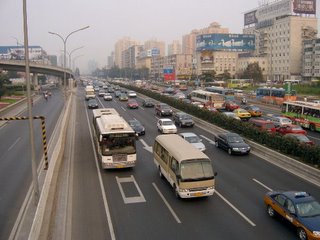Beijing is easily the largest city that I've been in. It's packed full of people who all have places to go. As you can imagine, this makes traffic very interesting. Most of the major streets in Beijing resemble highways. They are four lanes each way, plus a bicycle lane, making most major streets 9 lanes wide. The actual flow of traffic is a little different than in North American. The flow of traffic never seems to stop, even if there are accidents or obstructions. Like water in a stony river, traffic will go around things that block their way or drive in between lanes if there is space. This close-quarters driving must have evolved from bicycle traffic, as you will see a lot of cyclists doing this sort of thing in North America.
The cars in Beijing and most of China are predominately small European cars, specifially Volkswagons. There were also Korean and Chinese models. (Japanese cars were not as popular as I thought they would be, but there may be historical reasons for that.) American cars were very rare, but I did see a few Fords on the road. Cars have become a status symbol in China. It means something if you have a car. It really means something if you have a black Audi or a black Mercedes-Benz. Personally, I'm a fan of bikes, and there are still plenty of those to be found on the road, even on a cold December night.
If you can't afford a car, or want to avoid the slow traffic of rush hour, Beijing has a very effective subway system that only costs 3 yuan to take. In contrast, their bus system is very strange. There are official buses that follow fixed routes and require fixed fares of 2 yuan. Aside from the official buses there are another class of buses which look a little more shady. I'm not sure if these other buses are legit or not, but you can flag then down anywhere, and if you are travelling a short distance, then you can try to haggle down your fare. These buses are very tightly packed, and I really wonder if they are just some local guys that rented an old bus to make money. I've seen official buses and shady buses race each other and cut each other off to get customers. Personally, I think this is something I'd like to see in Toronto, with the TTC being a little too complacent with their transit monopoly.
Taxis can be found everywhere, and they are a small luxury to those that can afford it. The average taxi trip costs between 15 to 30 yuan. There are some taxi options in China that we don't have here. Aside from they standard taxi car, they also have 3-wheeled cycle-taxis with an enclosed passenger cabin in the back. These seem to have replaced the old rickshaws, especially because they are faster. A similar option is the 3-wheeled motorcycle-taxi with passenger cabin. We actually took one of these, and found it to be a noisy but fast way to get around. It's really a down-to-earth way to travel because you can feel every bump or hole on the road when you are in one of those things. I loved the run-down appearance of some of them, because you think the whole thing is going to fall apart on you when you reach the next intersection. Very exciting.
Of course, my favorite transportation method in China was "some guy with a car." When you walk out of a subway station or restaurant, some guy will approach you and quietly ask if you need a lift. You haggle a reasonable price and get into his car. This practice is competely illegal, but nobody seems to care. One of the things they like to do is to park in front of an apartment complex and give people a ride to the subway station. They will only go once the car is full, so you may be waiting for a 3rd or 4th person to hop into the car with you before his drives everyone to the station.
Wednesday, January 04, 2006
Subscribe to:
Post Comments (Atom)



No comments:
Post a Comment